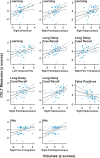Structural MRI Correlates of Episodic Memory Processes in Parkinson's Disease Without Mild Cognitive Impairment
- PMID: 26577652
- PMCID: PMC4754077
- DOI: 10.3233/JPD-150652
Structural MRI Correlates of Episodic Memory Processes in Parkinson's Disease Without Mild Cognitive Impairment
Abstract
Background: Changes in episodic memory are common early in Parkinson's disease (PD) and may be a risk factor for future cognitive decline. Although medial temporal lobe (MTL) memory and frontostriatal (FS) executive systems are thought to play different roles in distinct components of episodic memory impairment in PD, no study has investigated whether different aspects of memory functioning are differentially associated with MTL and FS volumes in nondemented patients without mild cognitive impairment (PD-woMCI).
Objectives: The present study investigated MRI markers of different facets of memory functioning in 48 PD-woMCI patients and 42 controls.
Methods: Regional volumes were measured in structures comprising the MTL and FS systems and then correlated with key indices of memory from the California Verbal Learning Test.
Results: In PD-woMCI patients, memory was impaired only for verbal learning, which was not associated with executive, attention/working memory, or visuospatial functioning. Despite an absence of cortical atrophy, smaller right MTL volumes in patients were associated with poorer verbal learning, long delayed free recall, long delayed cued recall, and recognition memory hits and false positives. Smaller right pars triangularis (inferior frontal) volumes were also associated with poorer long delayed cued recall and recognition memory hits. These relationships were not found in controls.
Conclusions: The findings indicate that MTL volumes are sensitive to subtle changes in almost all facets of memory in PD-woMCI, whereas FS volumes are sensitive only to memory performances in cued-testing formats.
Keywords: Parkinson’s disease; cognitive functions; frontostriatal system; magnetic resonance imaging; medial temporal lobe system; memory; neuropsychology.
Figures


References
-
- Aarsland D, Andersen K, Larsen JP, Lolk A, Kragh-Sorensen P. Prevalence and characteristics of dementia in Parkinson disease: An 8-year prospective study. Arch Neurol. 2003;60:387–392. - PubMed
-
- Aarsland D, Larsen JP, Tandberg E, Laake K. Predictors of nursing home placement in Parkinson’s disease: A population-based, prospective study. J Am Geriatr Soc. 2000;48:938–942. - PubMed
-
- Hughes TA, Ross HF, Mindham RH, Spokes EG. Mortality in Parkinson’s disease and its association with dementia and depression. Acta Neurol Scand. 2004;110:118–123. - PubMed
-
- Broeders M, Velseboer DC, de Bie R, Speelman JD, Muslimovic D, Post B, de HR, Schmand B. Cognitive change in newly-diagnosed patients with Parkinson’s disease: A 5-year follow-up study. J Int Neuropsychol Soc. 2013;19:695–708. - PubMed
-
- Muslimovic D, Post B, Speelman JD, Schmand B. Cognitive profile of patients with newly diagnosed Parkinson disease. Neurology. 2005;65:1239–1245. - PubMed
Publication types
MeSH terms
Grants and funding
LinkOut - more resources
Full Text Sources
Medical
Miscellaneous

